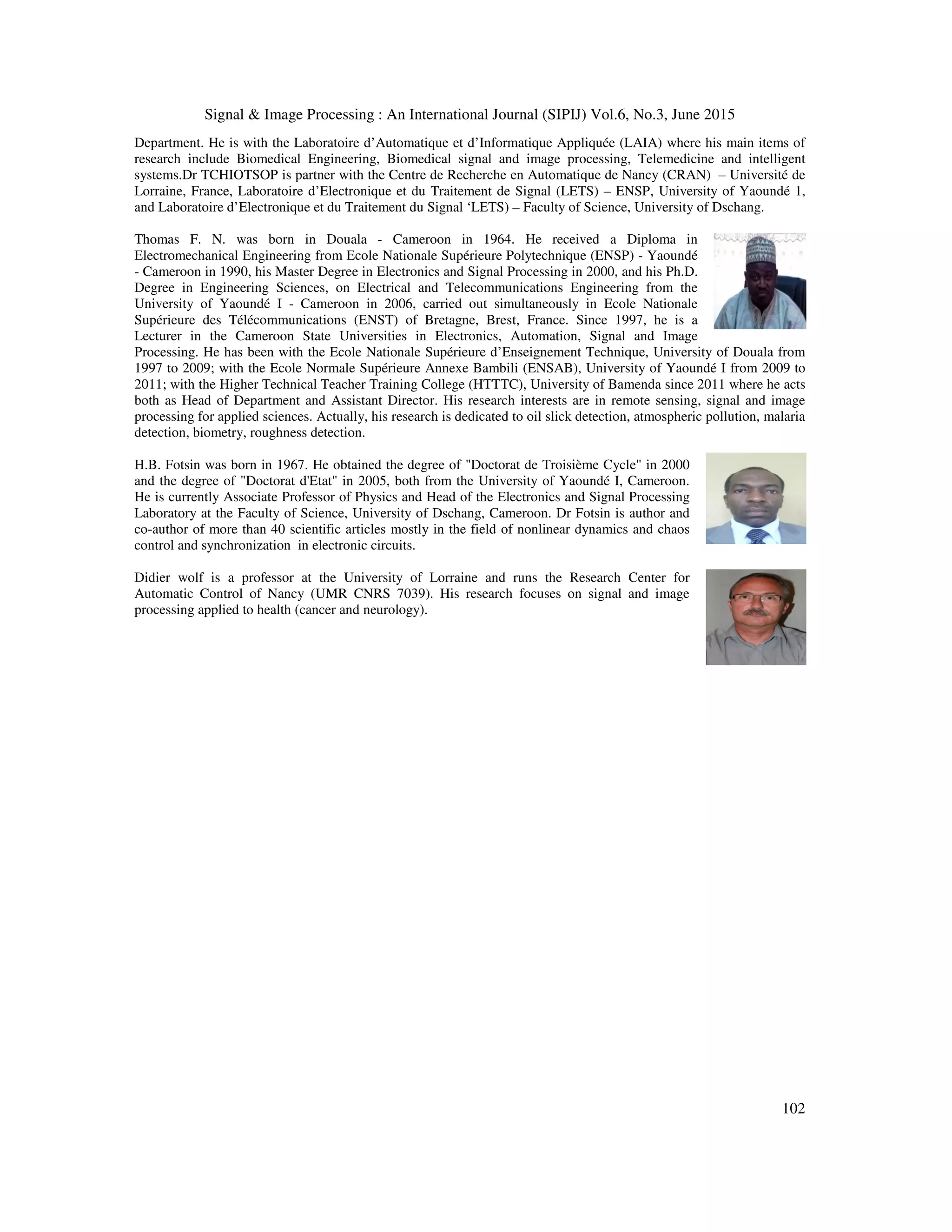This document presents a new image encryption scheme that combines chaotic logistic maps with the fast Walsh transform (FWT) for secure biomedical image transmission. The proposed method enhances security through chaotic permutation and substitution processes during the FWT, making it robust against attacks compared to conventional techniques. Experimental results demonstrate the effectiveness and efficiency of this algorithm for real-time encryption of grayscale images.
![Signal & Image Processing : An International Journal (SIPIJ) Vol.6, No.3, June 2015
DOI : 10.5121/sipij.2015.6307 81
A ROBUST CHAOTIC AND FAST WALSH
TRANSFORM ENCRYPTION FOR GRAY SCALE
BIOMEDICAL IMAGE TRANSMISSION
Adélaïde Nicole Kengnou Telem1
, Daniel Tchiotsop1
, Thomas Kanaa2
,
Hilaire B. Fotsin3
, Didier Wolf4
1
Laboratoire d’Automatique et d’Informatique Appliquée (LAIA), Department of Electrical
Engineering, IUT FV, University of Dschang, P.O. Box 134 Bandjoun – Cameroon.
2
Laboratoire d’Electronique, Electrotechnique, Automatique et Télécommunications,
Université de Douala, B.P. 1872 Douala.
3
Laboratory of Electronics and Signal Processing, Faculty of Science, University of Dschang,
P.O Box. 067 Dschang, Cameroon.
4
Centre de Recherche en Automatique de Nancy (CRAN) UMR CNRS 7039, ENSEM
Université de Lorraine, Nancy, France.
ABSTRACT
In this work, a new scheme of image encryption based on chaos and Fast Walsh Transform (FWT) has been proposed.
We used two chaotic logistic maps and combined chaotic encryption methods to the two-dimensional FWT of images.
The encryption process involves two steps: firstly, chaotic sequences generated by the chaotic logistic maps are used to
permute and mask the intermediate results or array of FWT, the next step consist in changing the chaotic sequences or
the initial conditions of chaotic logistic maps among two intermediate results of the same row or column. Changing the
encryption key several times on the same row or column makes the cipher more robust against any attack. We tested
our algorithms on many biomedical images. We also used images from data bases to compare our algorithm to those
in literature. It comes out from statistical analysis and key sensitivity tests that our proposed image encryption scheme
provides an efficient and secure way for real-time encryption and transmission biomedical images.
KEYWORDS
Image Encryption, Chaotic Logistic Map, Fast Walsh Transform, Telemedicine
1. INTRODUCTION
The fascinating developments in digital image processing and network communications during the past decade
have created a great demand for real-time secure image transmission over the Internet and through wireless
networks. In the past decade, images had been coded using orthogonal transform techniques such as Fourier
transform coding [1-4], Hadamard Transform image coding and Walsh Hadamard Transform image. coding [5-
9]. Fast algorithms have been designed to improve the speed of those techniques. They are known as Fast Fourier
Transform coding (FFT) and Fast Hadamard Transform (FHT). Some variants of FHT are the Fast Walsh
Hadamard Transform (FWHT) and Fast Walsh Transform (FWT). PRATT et al [10] has investigated a
combination of Hadamard Transform to uniform quantization. Fundamental properties of the Hadamard
transform have been discussed in conjunction with image coding application. It has been shown that the
Hadamard Transform is better than the Fourier transform for image coding [10]. The Hadamard Transform has](https://image.slidesharecdn.com/50-150708045854-lva1-app6891/75/A-ROBUST-CHAOTIC-AND-FAST-WALSH-TRANSFORM-ENCRYPTION-FOR-GRAY-SCALE-BIOMEDICAL-IMAGE-TRANSMISSION-1-2048.jpg)
![Signal & Image Processing : An International Journal (SIPIJ) Vol.6, No.3, June 2015
82
several interesting properties. The most important properties from the standpoint of image coding are dynamic
range, conservation of energy, and entropy. Hadamard Transform is faster than Fourier Transform [10]. All these
transforms have the disadvantage that the coded image can be easily decoded by just applying the inverse
transformation. So, the security of information is not guaranteed by using only these techniques.
Image encryption is the most useful technique to retain the confidentiality when images are stored or transmitted.
Telemedicine for instance uses telecommunications technology to transmit medical images of a patient to a
doctor who is at a distance. The confidentiality of medical information being essential, these images must be
secured before, during and after transmission. Digital images, as it is known from the bibliography, have some
very important features such as, bulk data capacity, strong correlation among adjacent pixels, redundancy of
data, being less sensitive compared to the text data and existence of patterns and background [11]. So,
concerning the above mentioned features, traditional ciphers like Data Encryption Standard (DES), Advanced
Encryption Standard (AES), International Data Encryption Algorithm (IDEA) and Rivest-Shamir-Adleman
(RSA), are not suitable for real time image encryption as these ciphers require a large computational time and
high computing power. Nowadays, the position permutation, which is used in a great number of conventional
image encryption algorithms, has the advantage to be fast. However, the security of these methods depends on
the security of the algorithm, which does not satisfy the basic requirement of a modern encryption scheme.
In recent years, chaos based methods has been used for image encryption. Chaos is suitable for image
encryption, as it is closely related to some dynamics of its own characteristics and refers to unpredictability. The
behavior of the chaos system, under certain conditions, results phenomena which are characterized by
sensitivities to the initial conditions and to the system parameters. Through the sensitivities, the system responses
act to be random. The main advantages of the chaotic encryption approach include: high flexibility in the
encryption system design, good privacy due to both nonstandard approach and vast number of variants of chaotic
systems, large, complex and numerous possible encryption keys and simpler design.
I.S.I. Abuhaiba and M.A.S. Hassan proposed in [12] and improved encryption method based on two dimensional
Fourier Transform, crossover operation and the use of a keyed mutation function. In [13], B.K.
Shreyamshakumar et al showed that, image cryptosystem usually manipulates an entire data set without any
presumption about compression at later time; consequently, the secure transmission of image has become more
costly in term of time, bandwidth and complexity. A novel image encryption technique that conserves the
compression ratio is proposed. The algorithm is embedded as a part of JPEG image encoding scheme. Firstly,
fuzzy PN sequence is used to confuse the modified Direct Cosine Transform (DCT) blocks. Then the DCT
coefficients of each modified (DCT) block are converted to unique uncorrelated symbols, which are confused by
another fuzzy PN sequence. Finally, the variable length encoded bits are encrypted by chaotic stream cipher. To
overcome the weakness of some cryptosystem, Anil Kumar and M.K. Ghose in [14] used chaotic standard map
and linear feedback shift register to extend substitution- diffusion stage in cryptosystem. The number of round
depends on pseudo-random sequence and original image. Vinod Patidar et al [15] used a secret key of 161-bits to
provide a novel and robust chaos based pseudo random permutation - substitution scheme for image encryption.
The key gives the fix number of rounds. Preliminary permutation, substitution and main permutation are done
row-by-row and column-by-column instead of pixel-by-pixel. An efficient permutation – diffusion mechanism is
used by Ruisong Ye [16]. A generalized Arnold map and Bernoulli shift map are employed in permutation and
diffusion process. One chaotic orbit from Arnold map is used to get two index order sequences for the
permutation. The two generalized maps are used to provide two pseudo-random gray value sequences for a two-
way diffusion of gray values. Lin Teng and Xingyuan Wang in [17] proposed a bit-level image encryption
algorithm based on spatiotemporal chaotic system which is self adaptive. The ciphered images depend on the
plain image. The execution time is reduced by using a bit-level encryption. M. Khan and T. Shah in [18] used
fractional Rössler chaotic system to product nonlinear component which can be used as block cipher with strong
cryptographic properties.
In [19], Xiaoling Huang and Guodong Ye replace traditional chaotic confusion-diffusion architectures by a non
linear traverse on the plain image. They used dependent diffusion and reverse 2 dimensional map. J.S. Armand
Eyebe Fouda et al [20] proposes a method to overcome the time–consuming of image encryption based on
chaos. This algorithm uses a one round encryption scheme for the fast generation of large permutation and
diffusion keys based on the sorting of the solution of Linear Diophantine Equation (LDE). But the LDE is too
complex compared to the simple chaotic logistic map. The hybrid scheme that combines a chaos-based](https://image.slidesharecdn.com/50-150708045854-lva1-app6891/75/A-ROBUST-CHAOTIC-AND-FAST-WALSH-TRANSFORM-ENCRYPTION-FOR-GRAY-SCALE-BIOMEDICAL-IMAGE-TRANSMISSION-2-2048.jpg)
![Signal & Image Processing : An International Journal (SIPIJ) Vol.6, No.3, June 2015
83
watermarking algorithm is proposed by E.Chrysochos et al in [21]. Two different watermarks and chaos are
used. The first one is embedded in frequency domain combined with a two dimensional chaotic function. The
second one is embedded in luminosity histogram of the image. In [22], Osama S. suggests a modification on the
standard map and used it for confusion-diffusion mechanism in chaotic image cryptosystem. The plain image is
firstly shuffled by a modification of standard chaotic map for many rounds. Then, the shuffled image is diffused
by Henon chaotic map. Several rounds are necessary to achieve the goal of encryption. Jun-xin Chen et al in [23]
used a dynamic state variables selection mechanism to accelerate the encryption, enhance the security and
promote the efficiency of chaos based image cryptosystem. Two chaotic state variables are used to encrypt one
plain pixel, this make the encryption not fast. Quan Liu et al, in [24] used the couple map lattice based on the
chaos with Markov properties as a key stream generator to construct a novel image encryption algorithm.
Narendra Singh and Aloka Sinha [25] proposed a new method for image encryption using fractional Fourier
transform and chaos theory. Random phase masks are generated using iterative chaos function. Heba M. et al in
[26] improves the security of scrambling: scrambling blocks instead of individual pixels reduce the computation
time; scrambling in another domain in order to overcome the drawbacks of spatial-domain scrambling; making
such that the key stream depends on the plain image in order to resist the chosen-plaintext and known-plaintext
attacks. They used three different modes of cipher operation block chain, cipher feedback and output feedback to
implement 2D chaotic Baker map for scrambling in the Fractional Fourier Transform domain on digital images.
The initialization vector works as the main key. In [27], a single channel color image encryption has been
proposed based on iterative fraction Fourier transform and two-coupled logistic map by L. Sui and B. Gao. But
fast Fourier transform is not as fast as Fast Walsh Hadamard transform. Zhang Ya-hong et al [28] proposed a
binary image encryption algorithm based on chaos map and discrete Walsh transform is proposed. Firstly, chaos
sequence is used to encrypt the image, and then the encryption image is scrambled by the discrete Walsh
transform, which can achieve high-strength encryption. The chaotic operations are taken out before discrete
Walsh transforms and his algorithm is applied on binary images.
In this work, our aim is to highly secure a coded image using chaos and FWT. Our method is very different from
the scheme in [28]. We do apply the chaotic image encryption techniques during the FWT process, and we can
use both binary and gray scale images. We combine a two- dimensional FWT and chaos methods encryption to
produce a new image encryption system. We use two logistic chaotic maps, an external secret key to chaotic
permutation and substitution in FWT of the image. The computation of the FWT of image needs several
intermediate steps; when changing the position of pixels in the intermediate step results by using chaotic
permutation. The pixel values are also change by XOR convolution with chaotic sequences. This acts to secure
and hide information better than a simple FWT. The new cryptosystem is simple, efficient and robust. The
results show the effectiveness of the algorithm.
In the rest of the paper, we describe the preliminary notions of FWT and logistic map in section 2, section 3
contains the description of our encryption system and section 4 presents the experimental results and security
analysis. A conclusion ends the paper.
2. WALSH HADAMARD TRANSFORM AND LOGISTIC MAP
2.1 Walsh Hadamard matrices
The binary orthogonal Walsh functions are defined in the space of real numbers. These functions do take only
two values: +1 and -1. A Walsh function is characterized by its position or by its sequence s. The sequence ( s )
is the number of zero crossings of waveform. It therefore increases with the number of time that the waveform
alternates in sign. We can notice that the difference between Walsh matrix and Hadamard matrix is the order of
sequence appearance. In Walsh matrix, sequences appear in decimal order.
The discrete Walsh functions are periodic with period N, where N is an integral power of two
( 2p
N = ). Thus a complete orthogonal set will have N distinct functions. These functions designated
( , )wal m n are described by equations (1) and (2) as proved in [29].
(0, ) 1;wal n = for n=0,1,2,…..N-1.](https://image.slidesharecdn.com/50-150708045854-lva1-app6891/75/A-ROBUST-CHAOTIC-AND-FAST-WALSH-TRANSFORM-ENCRYPTION-FOR-GRAY-SCALE-BIOMEDICAL-IMAGE-TRANSMISSION-3-2048.jpg)
![Signal & Image Processing : An International Journal (SIPIJ) Vol.6, No.3, June 2015
84
1 0,1,....( 1)
2(1, )
1 , 1,... 1
2 2
N
for n
w al n
N N
for n N
= −
=
− = + −
(1)
( , ) ( , 2 ). ( 2 , )
2 2
m m
wal m n wal n wal m n
= −
(2)
Where
2
m
indicates the integer part of
2
m
2.2 The Fast Walsh Transform (FWT)
Figure1: Flow graph for the 8-length Walsh transform [29]
Given an N-length real array f(n), we can define the Walsh transform as [29] :
1
0
( ) ( ) ( , )
N
n
F m f n wal m n
−
=
= ∑ ; m=0, 1, . . . N-1. (3)
Similarly, the inverse transform is
1
0
1
( ) ( ) ( , )
N
n
f n F m wal n m
N
−
=
= ∑ ; n=0, 1, …N-1 (4)
In [29], JOHN L. SHANKS describes a computation algorithm analogous to the cooley-Tukey algorithm. The
computation of (3) and (4) requires no multiplication. The algorithm requires 2NLog N summation to
compute a complete Walsh transform rather than
2
N as indicated by equation (3). Figure 1 shows the flow
graph for the 8-lenght Walsh transform.
A1 and A2 are intermediate steps before the final result A3 or F (m). For the general case when 2p
N = , the
intermediate Walsh transform arrays are defined by:
1
1
0 1 1 1 0 1 0 1 2 1 0
0
( , ,... , ,...., ) ( , ,... , ,...., )( 1) l p l
p l
j k
l l p l l l p l
k
A j j j k k A j j j k k − −
−
− − − − − − −
=
= −∑ (5)
Where 1,2,....l p= and
0 1 2 0 1 2 0( , ,... ) ( , ,... )p p p pA k k k f k k k− − − −= (6)
The general equation for the 2p
N = - length discrete Walsh function is then
1
1
1 2 0 1 2 0
0
( , ,... ; , ,.... ) ( 1) p iki
p
j
p p p p
i
wal j j j k k k − −
−
− − − −
=
= −∏ (7)](https://image.slidesharecdn.com/50-150708045854-lva1-app6891/75/A-ROBUST-CHAOTIC-AND-FAST-WALSH-TRANSFORM-ENCRYPTION-FOR-GRAY-SCALE-BIOMEDICAL-IMAGE-TRANSMISSION-4-2048.jpg)
![Signal & Image Processing : An International Journal (SIPIJ) Vol.6, No.3, June 2015
85
Since ( , ) ( , )wal n m wal m n= , the inverse Walsh transform is identical to the Walsh transform with the
difference that all the values are divided by N. As 2p
N = , we have p-2 intermediate Walsh transform arrays
[29].
2.3 Walsh transformation of images
Let the array ( , )f x y representing the intensity samples of an original image over an array of
2
N points. The
two-dimensional Hadamard transform, ( , )F u v as proved in [27], of ( , )f x y is given by matrix product [10]
of equation (8).
[ ] [ ][ ][ ]( , ) ( , ) ( , ) ( , )F u v H u v f x y H u v= (8)
Where [ ]( , )H u v is an N order symmetric Hadamard matrix. The inverse two-dimensional Hadamard
transform, ( , )f x y , of ( , )F u v is also given by the matrix product of equation (9).
[ ] [ ][ ][ ]2
1
( , ) ( , ) ( , ) ( , )f x y H u v F u v H u v
N
= (9)
As a Walsh matrix is the sequence ordered Hamard matrix, we can compute the two-dimensional Walsh
transform by using (8) where Hadamard matrix is replaced by ordered Walsh matrix. PRATT et al have given in
[10] the series form of the two-dimensional Walsh Hadamard transform as expressed in (10).
1 1
( , , , )
0 0
( , ) ( , )( 1)
N N
p x y u v
x y
F u v f x y
− −
= =
= −∑ ∑ (10)
Where
1
0
( , , , ) ( )
n
i i i i
i
p x y u v u x v y
−
=
= +∑
The items iu , iv , ix and iy are the binary representations of u, v, x, and y respectively.
The walsh matrix which is the Hadamard “ordered” such that the sequence s of each row is larger than the
sequence of the preceding row, can be written as in (11).
1 1
( , , , )
0 0
( , ) ( , )( 1)
N N
q x y u v
x y
F u v f x y
− −
= =
= −∑ ∑ (11)
Where
1
0
( , , , ) ( ( ) ( ) )
n
i i i i
i
q x y u v u x v yρ ρ
−
=
= +∑
0 1( ) nu uρ −= ; 1 1 2( ) n nu u uρ − −= + ; 2 2 3( ) n nu u uρ − −= + ; . . . 1 1 0( )n u u uρ − = +
2.4 Logistic chaotic map
The typical chaotic dynamical systems, such as logistic map and Lorenz system can be used for image
encryption. The logistic map has been widely used because of its simplicity and its efficiency. It is
mathematically expressed by equation (12) in [30].
1 (1 )k k kX X Xµ+ = − (12)
Where 0 4µ< ≤ is called bifurcation parameter and kX is a real number in the range [0, 1]. The status of the
system depends on µ . The bifurcation diagram of the logistic is shown in figure 2.](https://image.slidesharecdn.com/50-150708045854-lva1-app6891/75/A-ROBUST-CHAOTIC-AND-FAST-WALSH-TRANSFORM-ENCRYPTION-FOR-GRAY-SCALE-BIOMEDICAL-IMAGE-TRANSMISSION-5-2048.jpg)
![Signal & Image Processing : An International Journal (SIPIJ) Vol.6, No.3, June 2015
86
Figure 2: bifurcation diagramme of logistic map
We can see in the diagram that for 3.569955672 <m <= 4, the mapping has a chaotic form. With different initial
conditions oX , the generated sequences kX are non-correlated, non periodic and non-converging. The system
is very sensitive to the initial condition oX . In image encryption; this characteristic is used to generate different
sequences only by changing the initial condition oX .Those sequences are easy to generate and seem to be like
white noise. They are used in permutation-diffusion process of encryption.
The probability density function of logistic map which is shown in Figure 3 can be described as follows.
2
1
1 1
( ) 1
0 otherw ise
x
x xρ π
− < <
= −
(13)
Figure 3: Probability density of Logistic map
It comes from figure 3 that the probability density of a Logistic map is symmetric; ρ(x) does not depend on the
initial value X0, indicating that the chaos system is ergodic.
3. THE CHAOTIC-FWT IMAGE ENCRYPTION ALGORITHM
Our proposed encryption scheme of gray-scale image, which has been implemented in MATLAB, is presented in
detail in this section. We use an external secret key, two chaotic logistic maps and the FWT to achieve the goal
of the encryption. Two basis of image encryption processes are used: the permutation and the substitution. For
image encryption methods based on chaos, those processes are applied directly on the pixel values of images. In
[28], those processes are used to encrypt the image and then the encryption image is scrambled by the discrete
Walsh transform. Thus, image encryption through chaos and the discrete Walsh transform are performed
separately.
In this work, we realize image encryption performing chaos and the discrete Walsh transform simultaneously.
Figure 4 illustrates our image encryption scheme. In the following paragraph, different steps of the scheme as
well as the complete description of our encryption algorithm are discussed.](https://image.slidesharecdn.com/50-150708045854-lva1-app6891/75/A-ROBUST-CHAOTIC-AND-FAST-WALSH-TRANSFORM-ENCRYPTION-FOR-GRAY-SCALE-BIOMEDICAL-IMAGE-TRANSMISSION-6-2048.jpg)
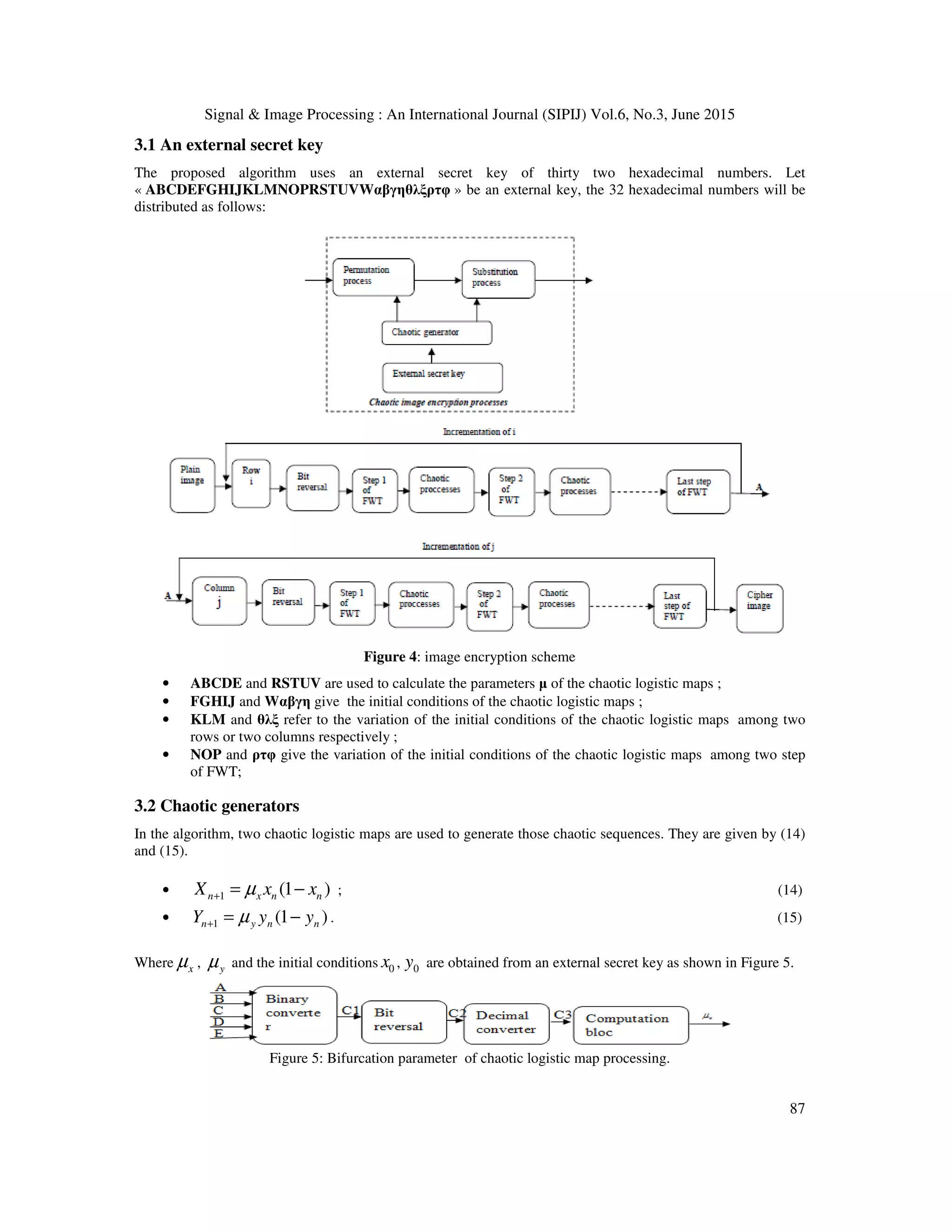
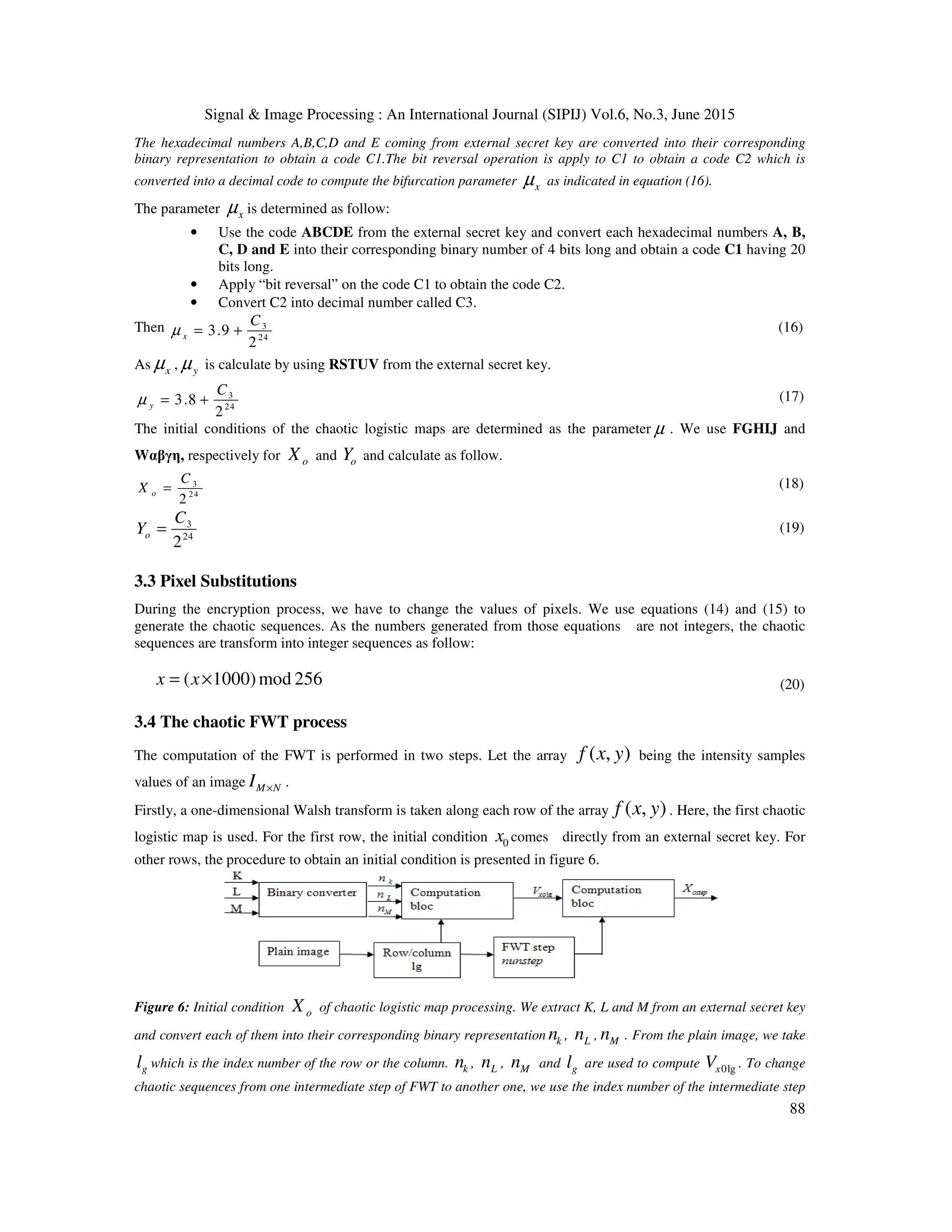
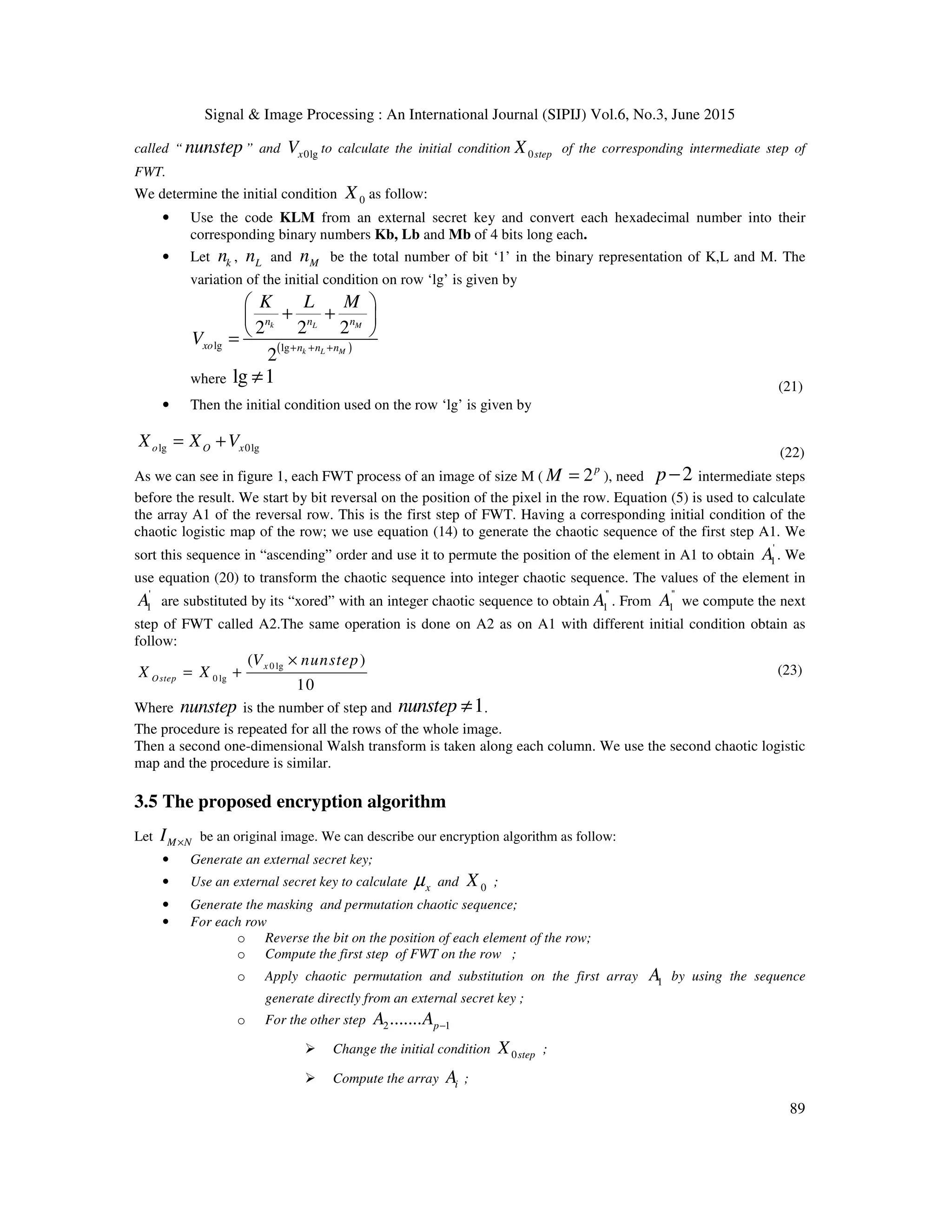
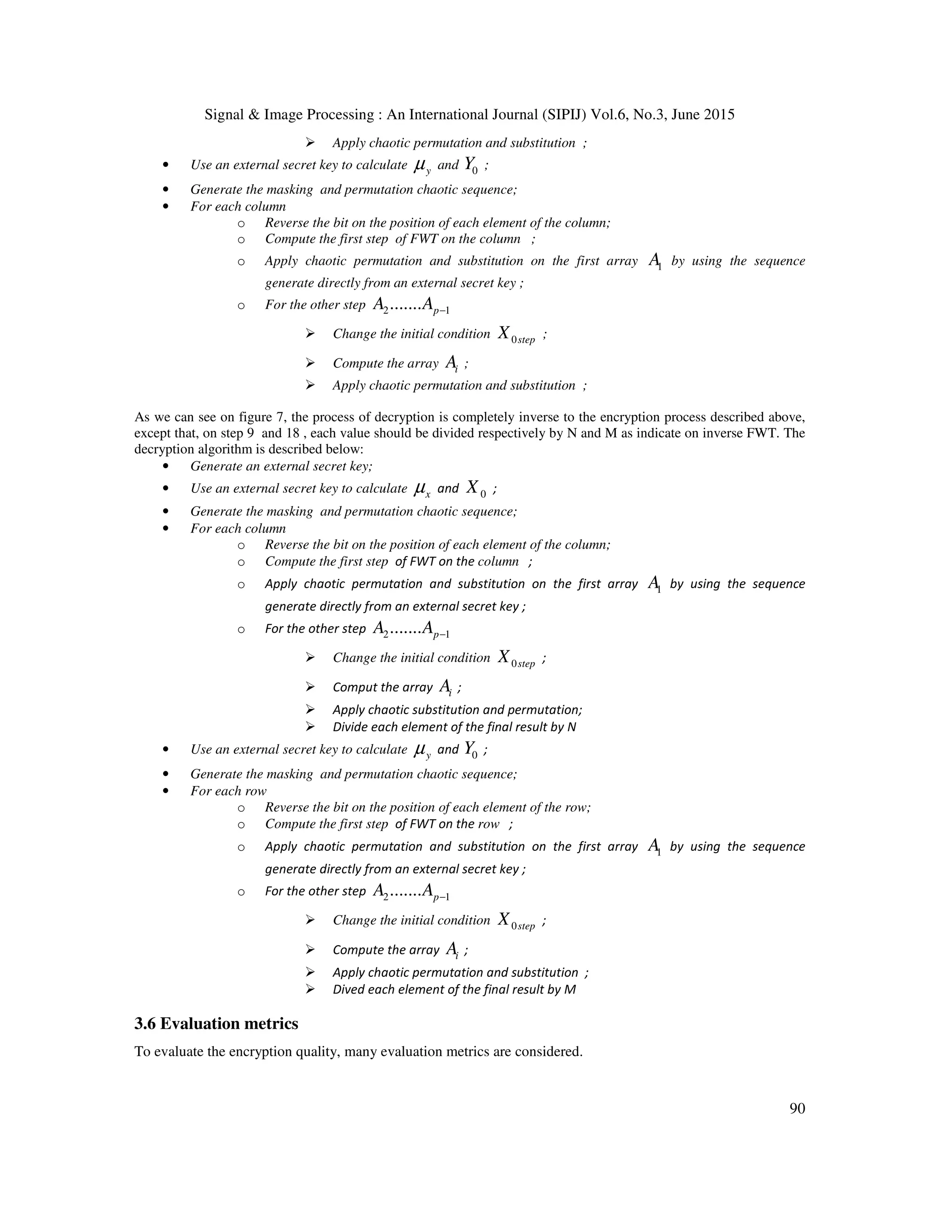
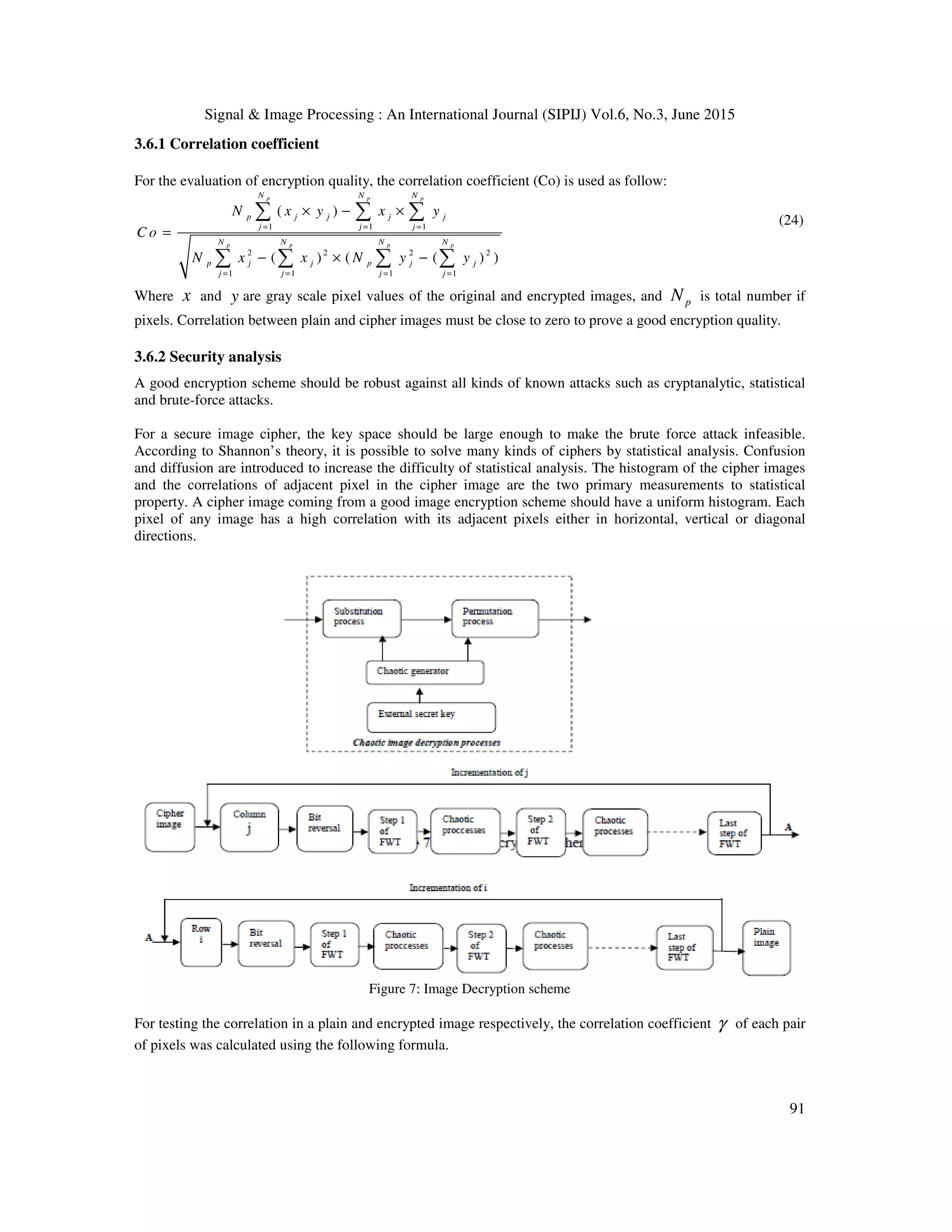
![Signal & Image Processing : An International Journal (SIPIJ) Vol.6, No.3, June 2015
92
1
1
( )
apN
i
iap
E x x
N =
= ∑
(25)
[ ]
2
1
1
( ) ( )
a pN
i
ia p
D x x E x
N =
= −∑
(26)
[ ][ ]
1
1
cov( , ) ( ) ( )
apN
i i
iap
x y x E x y E y
N =
= − −∑
(27)
cov( , )
( , )
( ) ( )
x y
x y
D x D y
γ =
(28)
In equations (25)-(28) x and y are the gray values of two adjacent pixels in the image and apN is the total
number of adjacent pairs of pixels.
The information entropy, introduced by Shannon, is one of the most important features of randomness.
Information entropy ( )H s is calculated by the following formula
1
2
0
1
( ) ( ) log ( )
( )
glN
i
i i
H s P s
p s
−
=
= − ∑
(29)
Where glN is the number of gray level in the image and ( )iP s shows the probability of appearance of the
symbol is .
3.6.3 Differential attacks
Two common measures, Number of Pixels Change Rate (NPCR) and Unified Average Changing Intensity
(UACI) are used to test the influence of changing a single pixel in the original image on the whole image
encrypted by the proposed algorithm. Therefore, if ( , )A i j and ( , )B i j are the pixels in row i and column j
of the encrypted images A and B, with only one pixel difference between the respective plain images, then the
NPCR is calculated by using the following formula:
,
( , )
100%
i j
D i j
NPCR
W H
= ×
×
∑
(30)
Where W and H are the width and height of A or B. ( , )D i j is produced as follow:
1 ( , ) ( , )
( , )
0
if A i j B i j
D i j
o th e r w is e
=
=
(31)
The second number (UACI) is calculated by the following formula.
,
( , ) ( , )1
( , ) 100%
255i j
A i j B i j
UACI A B
W H
−
= ×
×
∑
4 EXPERIMENTAL RESULTS AND SECURITY ANALYSIS
4.1 Experimental Results
Figure 8 shows the visual test of our encryption scheme on several medical gray scale images. An external secret
key used for this encryption is « 5A9FE86248A78612327A9E2339AB8C12 ». As one can see in Figure 8, there](https://image.slidesharecdn.com/50-150708045854-lva1-app6891/75/A-ROBUST-CHAOTIC-AND-FAST-WALSH-TRANSFORM-ENCRYPTION-FOR-GRAY-SCALE-BIOMEDICAL-IMAGE-TRANSMISSION-12-2048.jpg)
![Signal & Image Processing : An International Journal (SIPIJ) Vol.6, No.3, June 2015
93
is not visual similarity between cipher and original images. We tested many images and all the results were
conclusive. Looking at cipher images (figure8 (b, e and h)), it’s impossible to imagine which images have been
encrypted because the cipher images do not give any clue of original images. Visual test confirm that cipher
images is not like original one. From Figure 8 c, f and i, we notice the similarity between original and decrypted
images. The cipher images have been successful decrypted. Different external key were used and we obtained
the same results. Mathematically, we confirmed the test by checking many evaluations metrics.
4.1.2 Correlation test and entropy information analysis
An evaluation metric which tests the similarity between cipher and original images is correlation coefficient
(Co). Table 1 presents the Co values of several medical gray scale images of [31].
Figure 8: Visual test on some biomedical images using the secret key « 5A9FE86248A78612327A9E2339AB8C12 »:
Frame (a), (b) and (c) show a plain image “Entamoeba Coli trophozoite " and its corresponding cipher and decrypted
image respectively. Frame (d) ,(e) and (f) show a plain image “echopelv" and its corresponding cipher and decrypted
image respectively. Frame (g), (h) and (i) show a plain image “angio" and its corresponding cipher and decrypted
image respectively.
The greater is the value Co, the more similar are the compared images. When the compared images are identical,
we obtain the maximum and critical correlation value which is one. We can see from table 1 that all Co are very
closed to zero for ciphers, meaning that cipher images are not correlated with the original. The highest value
obtained using this key is 0.0064 for the Entamoeba hitolytica trophozoite_redim2. In the contrary, the decrypted
and the original images are always identical since all the corresponding correlations are one. In the case of 256
gray-scale images, truly random image entropy is equal to eight [20], which is the ideal value. As shown in table
1, we notice that the values obtained in the proposed scheme are very close to 8. The highest value is 7.9994 and
the smallest one is 7.9970. The plain images and the decrypted images have the same entropy information which
is, in all cases, as we can from table 1, smaller than the entropy information of cipher images. This indicates that
the chaotic FWT has hidden information randomly and information leakage in encryption process is negligible.
We also conclude the effectiveness of the algorithm because of the highest value of entropy information.](https://image.slidesharecdn.com/50-150708045854-lva1-app6891/75/A-ROBUST-CHAOTIC-AND-FAST-WALSH-TRANSFORM-ENCRYPTION-FOR-GRAY-SCALE-BIOMEDICAL-IMAGE-TRANSMISSION-13-2048.jpg)
![Signal & Image Processing : An International Journal (SIPIJ) Vol.6, No.3, June 2015
94
Table 1: Correlation coefficients an entropy information of some medical images from [31].
To prove the effectiveness of the algorithm on any type of image, we apply it on various other non medical
images. We have used the USC-SIPI image database which is a collection of digitized image available and
maintained by the University of Southern California [32]. We have chosen miscellaneous volume to measure the
correlation coefficient of several USC-SIPI image databases. Table 2 shows the results of those images. The
same as for medical images, correlations Co of images in table 2 are near to zero and the entropy information is
near to eight. The maximum value of Co is 0.0036. It is very low compared to the critical value 1. The entropy
information of plain image and decrypted image is also small than the decrypted one. Our algorithm is then
efficient not only on medical images but also on all types of images.
4.2 Security analysis
We discuss here the security analysis of the proposed image encryption algorithm such as key space
analysis, statistical analysis and various attacks.](https://image.slidesharecdn.com/50-150708045854-lva1-app6891/75/A-ROBUST-CHAOTIC-AND-FAST-WALSH-TRANSFORM-ENCRYPTION-FOR-GRAY-SCALE-BIOMEDICAL-IMAGE-TRANSMISSION-14-2048.jpg)
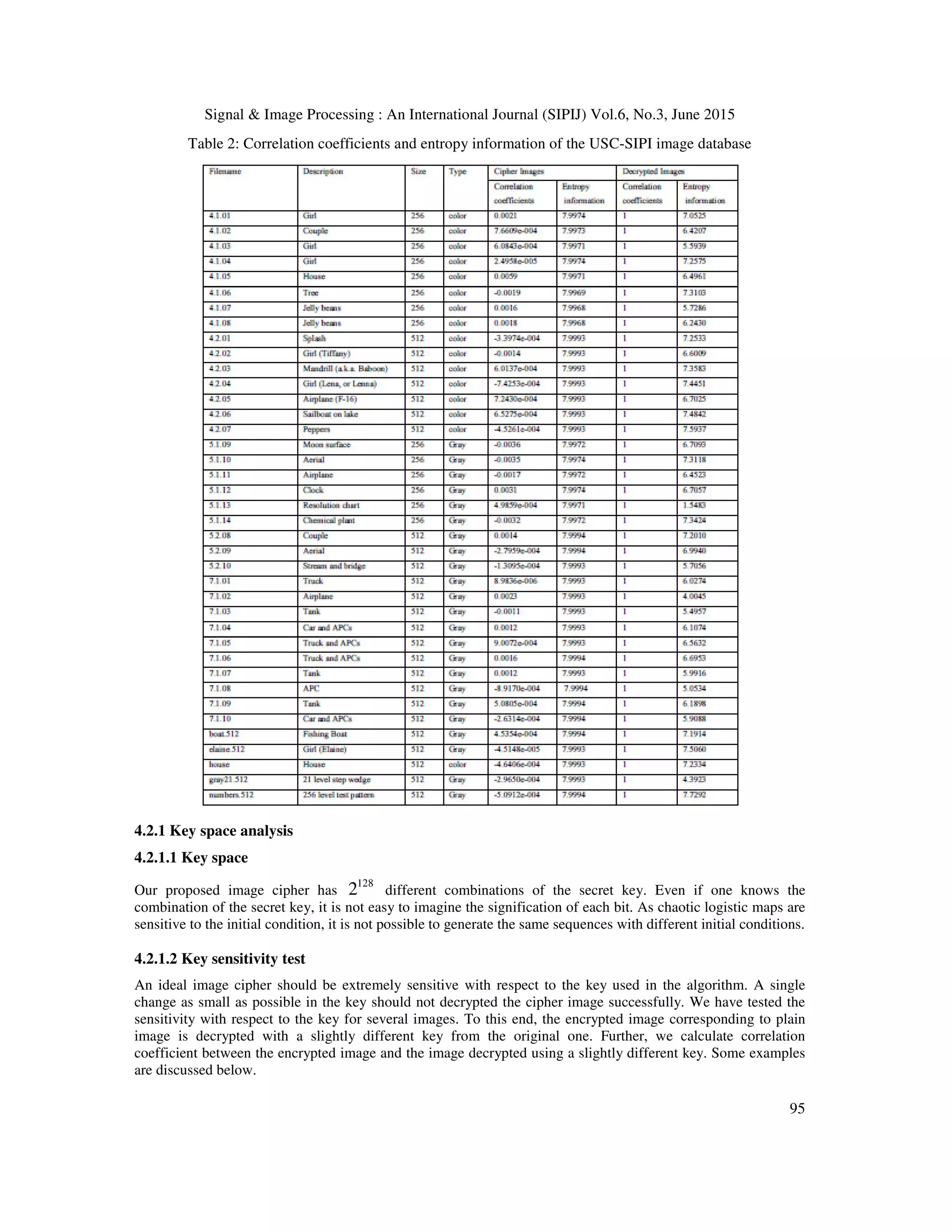
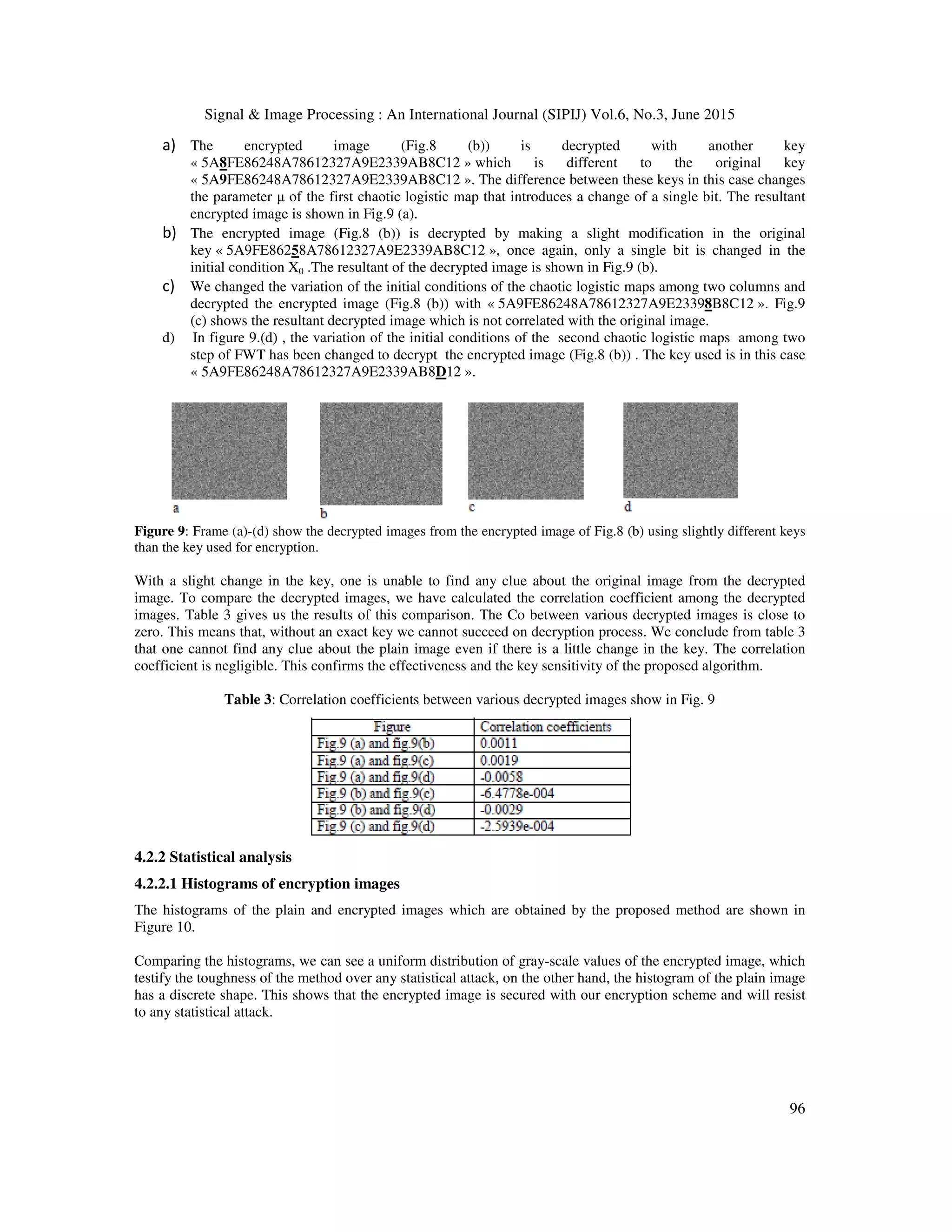
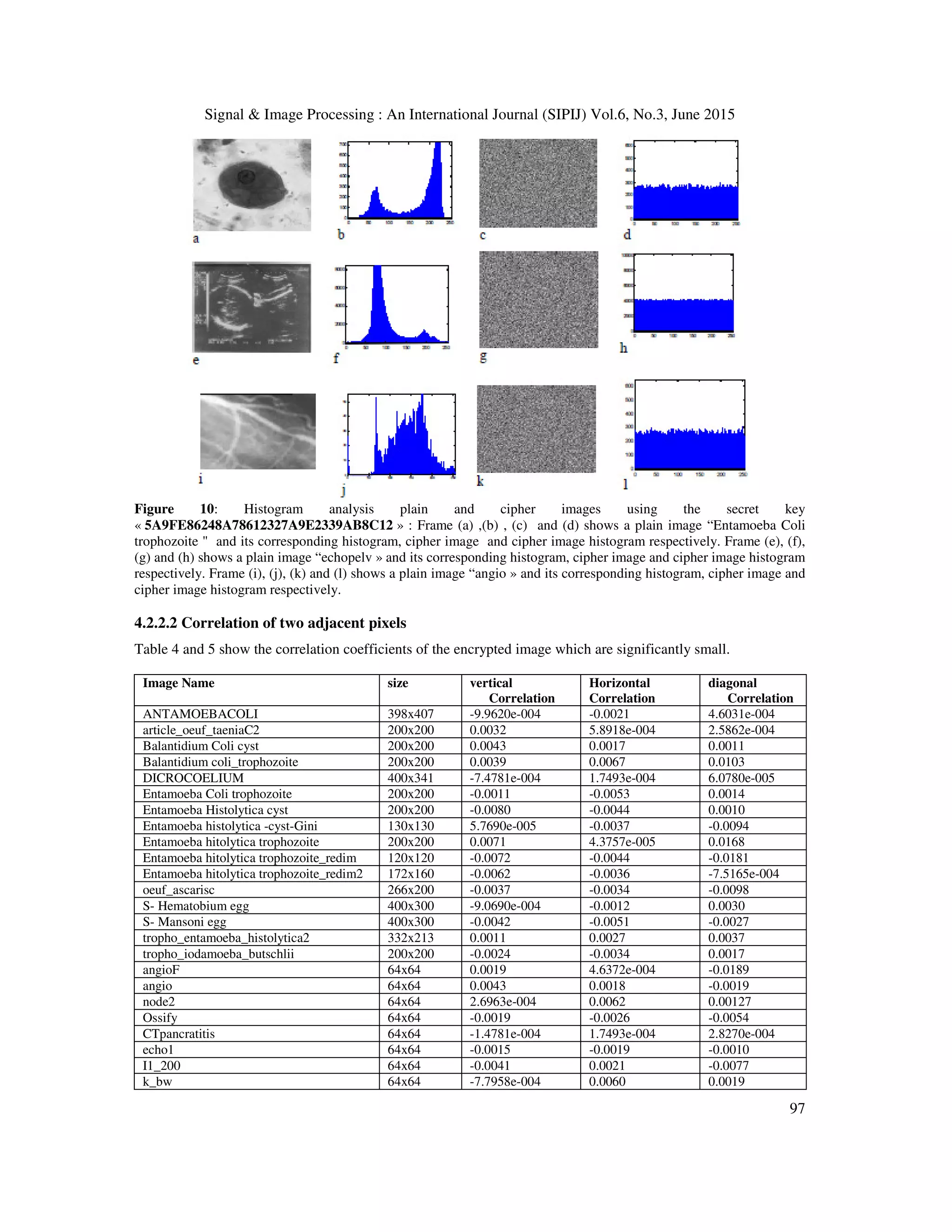
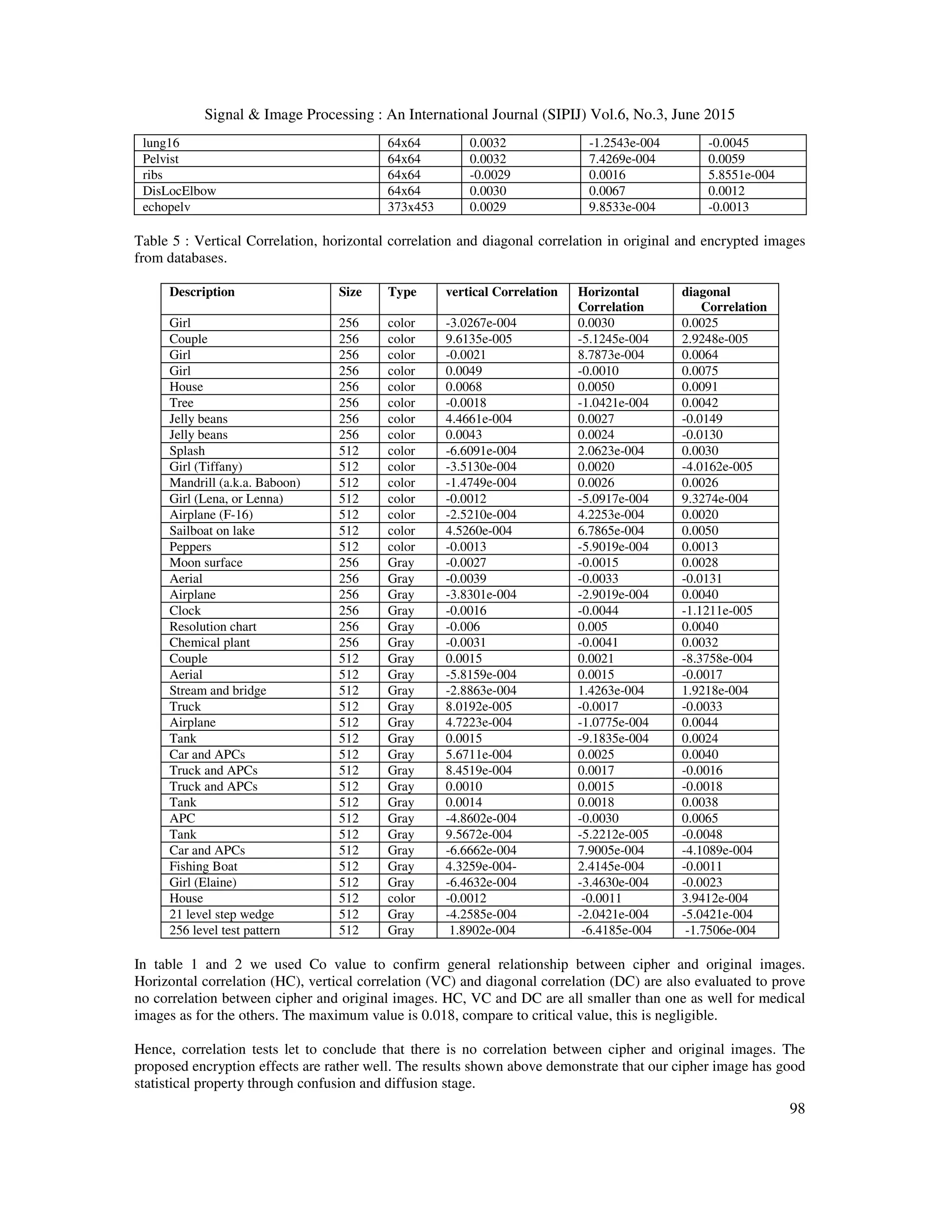
![Signal & Image Processing : An International Journal (SIPIJ) Vol.6, No.3, June 2015
99
4.2.3 Differential attacks
To test the influence of changing a single pixel in the original image, on the whole image encrypted by the
proposed algorithm, NPCR and UACI of many images have been calculated and presented in table 6. For a gray-
scale image, the NPCR is close to 99.6093% and the UACI is close to 33.33%.
Table 6: Values of NPCR and UACI of many medical images
Image Name size Corr(A,B) NCPR UACI
ANTAMOEBACOLI 398x407 -0.0031 99.6147 33.5323
article_oeuf_taeniaC2 200x200 -0.0021 99.5621 33.5172
Balantidium Coli cyst 200x200 -0.0068 99.6048 33.5938
Balantidium coli_trophozoite 200x200 -0.0013 99.6155 33.4818
DICROCOELIUM 400x341 0.0028 99.5972 33.4172
Entamoeba Coli trophozoite 200x200 0.0089 99.5819 33.2297
Entamoeba Histolytica cyst 200x200 -0.0058 99.6124 33.5771
Entamoeba histolytica -cyst-Gini 130x130 -0.0054 99.5987 33.5897
Entamoeba hitolytica trophozoite 200x200 0.0052 99.6017 33.2815
Entamoeba hitolytica trophozoite_redim 120x120 -0.0012 99.6094 33.5018
Entamoeba hitolytica trophozoite_redim2 172x160 -0.0018 99.6231 33.5405
oeuf_ascarisc 266x200 -0.0015 99.6132 33.5091
S- Hematobium egg 400x300 0.0042 99.5876 33.3906
S- Mansoni egg 400x300 0.0042 99.6056 33.3705
tropho_entamoeba_histolytica2 332x213 2.2082e-004 99.6078 33.4721
tropho_iodamoeba_butschlii 200x200 -0.0043 99.6170 33.5577
angioF 64x64 0.0032 99.6384 33.4193
angio 64x64 0.0075 99.5911 33.2566
node2 64x64 0.0031 99.5804 33.3958
Ossify 64x64 -0.0013 99.6307 33.4322
CTpancratitis 64x64 -2.7335e-004 99.6185 33.4818
echo1 64x64 0.0040 99.5667 33.3026
I1_200 64x64 -0.0025 99.6063 33.5109
k_bw.thumb 64x64 0.0033 99.6429 33.4121
lung16thumb 64x64 8.6350e-004 99.6094 33.4520
Pelvisthumb 64x64 0.0014 99.5804 33.4501
ribsthumb 64x64 0.0017 99.6048 33.4636
DisLocElbowthumb 64x64 0.0021 99.6063 33.4122
echopelv 373x453 0.0013 99.5941 33.4013
We found NPCR close to 99.6 % in all the cases tested. This proves that encryption scheme is very sensitive
with respect to a small percentage of pixels changes in the plain image. The UACI, in all the cases, is found close
to 33% indicating that the rate of influence due to one-pixel change in plain image is very high. The result of
these two tests shows that the proposed cipher is sensitive to a minor change in plain image. In order to compare
our algorithm to the existing schemes, we tested it on images usually used in the literature. The comparative
results are presented in table 7.
Table 7: comparison of results
Evaluation
metrics
Images
References
Lena Mandrill Airplane
Vertical
correlation
Ref [18] 0.0034 -0.0019 -0.0036
Ref [31] -0.0016
Ref [15] -0.0194
ours -0.0012 -0.00014 -0.00038
Horizontal
correlation
Ref [18] 0.0026 -0.0014 -0.0017
Ref [31] 0.0031
Ref [15] 0.0241
ours -0.00050 0.0026 -0.00029](https://image.slidesharecdn.com/50-150708045854-lva1-app6891/75/A-ROBUST-CHAOTIC-AND-FAST-WALSH-TRANSFORM-ENCRYPTION-FOR-GRAY-SCALE-BIOMEDICAL-IMAGE-TRANSMISSION-19-2048.jpg)
![Signal & Image Processing : An International Journal (SIPIJ) Vol.6, No.3, June 2015
100
Diagonal
correlation
Ref [18] -0.0019 -0.0013 -0.0020
Ref [31] 0.0067
Ref [15] 0.0243
ours 0.00090 0.0026 -0.0040
Entropy Ref [18] 7.9992 7.9991 7.9990
Ref [31] 7.9952
Ref [15] 7.9974
ours 7.9993 7.9993 7.9993
NCPR Ref [18] 99.6201 99.6109 99.6178
Ref [31] >96
Ref [15] 93.6768
ours 99.6109 99.6475 99.6034
UACI Ref [18] 33.4006 33.4757 33.5370
Ref [31] 31.79
Ref [15] 33.3364
ours 33.4953 33.4980 33.3312
In [20], Linear Diophantine Equation (LDE), whose coefficients are integers and dynamically generated from
chaotic system, is used to encrypt images. The procedure to generate sequences used in permutation –diffusion
process is too complex. We used a simple logistic map and FWT to obtain better results than [20] as we can see
in table 7. In [33], chaos is not used in the encryption process. Comparison shows our encryption scheme
provides better results. In [17], a bit-level image encryption based on spatiotemporal chaotic system is used. Our
chaotic FWT image encryption has better results. The same observation is done in [26] where the generalized
Arnold and Bernoulli shift map are employed. According to table 7, the results obtained from our chaotic FWT
encryption scheme are the best.
5. CONCLUSIONS
In this work, a new scheme of image encryption based on chaos and FWT has been proposed to secure
biomedical images. This utilizes two chaotic logistic maps, an external secret key of 128 bits long and a two-
dimensional FWT. The parameter and the initial conditions for two logistic maps are derived using an external
secret key. It has been shown that it is possible to apply chaotic methods encryptions to the two-dimensional Fast
Walsh Transform of images. We have carried out statistical analysis, key sensitivity analysis to demonstrate the
security and the effectiveness of the new image encryption system. The main features of the proposed encryption
scheme are its simplicity, its efficiency, the high speed and high order of security. Our method also has better
confusion, diffusion and security. The method is robust against brute-force attacks because of the changing of the
initial conditions of the chaotic logistic maps during the process of rows and columns of the chaotic FWT. Our
algorithm is easy to implement and could be use in real time transmission of secured biomedical images in
telemedicine.
REFERENCES
[1] B.M Hennelly and J.T Sheridan,”Image encryption and the fractional Fourier transform”, Optik-International Journal for light
and Electron optics, vol.114, 2003, pp.251-265.
[2] H. C. Andrews and W. K. Pratt, “Fourier transform coding of images”, Presented at the 1968 Hawaii International Conf. on
System Sciences, Jan. 671-619, 1968.
[3] H. C. Andrews and W. K. Pratt, “Television bandwidth reduction by Fourier image coding”, presented at the Soc. of Motion
Picture and Television Engrs., 103 Tech. Conf., May 1968.
[4] E. 0. Brigham and R. E. Morrow, “The fast Fourier transform ” , IEEE Spectrum, vol. 4, Dec. 1967, pp. 63-70.
[5] J. L. Walsh, “A closed set of orthogonal functions,” Am. J. Math., vol. 45, 1923 pp. 5-24,
[6] N. J. Fine, “On the Walsh functions”, Trans. Am. Math. Soc., vol. 65, 1949, pp. 372-414.
[7] N. J. Fine, “The generalized Walsh functions”, Trans. Am. Math. Soc., vol. 69, 1950, pp. 66-77.
[8] G. W. Morgenthaler, “On Walsh-Fourier series”, Trans. Am. Math. Soc., vol. 84, 1957, pp. 472-507.
[9] K. W. Henderson, “Some notes on the Walsh functions”, IEEE Trans. Electronic Computers (Correspondence), vol. EC-13,
Feb. 1964, pp.50-52.
[10] PRATT et al, “Hadamard Transform Image Coding”, Proceedings of the IEEE, VOL. 57, No.1, Jan. 1969, pp. 58-67.
[11] M. S.Murty, D. Veeraiah and A. S. Rao “Digital signature and watermark methods for image authentication using
cryptography analysis”, Signal & Image processing: an International Journal, vol. 2, No 2, June 2011, pp. 170-179.](https://image.slidesharecdn.com/50-150708045854-lva1-app6891/75/A-ROBUST-CHAOTIC-AND-FAST-WALSH-TRANSFORM-ENCRYPTION-FOR-GRAY-SCALE-BIOMEDICAL-IMAGE-TRANSMISSION-20-2048.jpg)
![Signal & Image Processing : An International Journal (SIPIJ) Vol.6, No.3, June 2015
101
[12] I. S. I. Abuhaiba and M. A. S. Hassan, “Image encryption using differential evolution approach in frequency domain”, Signal
& Image processing: An International Journal, Vol. 2, No 1, March 2011, pp. 51-69.
[13] B.K.Shreyamshakumar and C. R. Patil, “ JPEG image encryption using fuzzy PN sequences ”, Signal, Image and Video
Processing, Vol.4, Issue4, 2010, pp. 419-427.
[14] A. Kumar and M.K.Ghose, “Extended substitution-diffusion based image cipher using chaotic standard map”, Commun.
Nonlinear Sci.Num. Simul., Vol.16, 2011, pp. 372 - 382.
[15] V. Patidar, N.K. Pareek, G. Purohit and K.K Sud, “A robust and secure chaotic standard map based pseudorandom
permutation-substitution scheme for image encryption”, Optic Commun., Vol. 284, 2011, pp.4331-4339.
[16] R. Ye, “A novel chaos-based image encryption scheme with an efficient permutation-diffusion mechanism”, Optic Commun.,
Vol. 284, 2011, pp. 5290-5298.
[17] L. Teng and X. Wang, “A bit-level image encryption algorithm based on spatiotemporal chaotic system and self-adaptive”,
Optics Commun., Vol. 285, 2012,pp. 4048-4054.
[18] M. Khan and T. Shah, “An efficient construction of substitution box with fractional chaotic system”, Signal, Image and Video
Processing, 2013.
[19] W. Zhang, K.Wong, H. Yu and Z. Zhu, “An image encryption scheme using reverse 2-dimensional chaotic map and dependent
diffusion”, Commun. Nonlinear Sci. Num. Simul., Vol. 18, 2013, pp. 2066-2080.
[20] J.S. Eyebe Fouda, J.Yves Effa, L. Samrat, and A. Maaruf, “A fast chaotic block cipher for image encryption”, Commun.
Nonlinear Sci.Num. Simul., vol. 19, 2013, pp. 578-588.
[21] E.Chrysochos, V.Fotopoulos,M.Xenos and A.N.Skodras, “ Hybrid watermarking based on chaos and histogram modification
”, Signal, Image and Video Processing, Vol.8,Issue5, 2014, pp. 843-857.
[22] O. S. Faragallah, “Efficient confusion – diffusion chaotic image cryptosystem using enhanced standard map”, Signal, Image
and Video Processing, 2014; doi: 101007/s11760-014-0683-y
[23] J-X. Chen, Z-l. Zhu, C. Fu, H. Yu and L-B. Zhang, “A fast chaos-based image encryption scheme with a dynamic state variable
selection mechanism”, Commun. Nonlinear Sci.Num. Simul., Vol. 20, 2015, pp. 846-860.
[24] Q. Liu, P-Y. Li, M-C. Zhang, Y-X. Sui and H-J. Yang, “A novel image encryption algorithm based on chaos maps with
Markov properties”, Commun. Nonlinear Sci.Num. Simul., Vol. 20, 2015,pp. 506-515.
[25] N. Singh, and A. Sinha, “Optical image encryption using fractional Fourier transform and chaos”, Optics and Lasers in
Engineering 46, 2008, pp .117-123.
[26] H. M.Elhoseny, H. E.H.ahmed, A. M.Abbas et al, “ chaotic encryption of images in the fractional Fourier Transform domain
using different modes of operation ”, Signal, Image and Video Processing, vol. 9, 2015, pp. 611-622
[27] L. Sui, B. Gao, ”Single- channel color image encryption based on iterative fractional Fourier transform and chaos”, Optics &
Laser Technology 48, 2013, pp. 117-127.
[28] Z. Ya-hong, L. Xin-wei, and C. Hui., “Binary Image Encryption Algorithm Based on Chaos and Walsh Transform” [J], 2011,
Issue 3, pp.60-62, Doi:10.3969/j.issn;1006-2475.2011.03.016.
[29] J. L. SHANKS, “Computation of the Fast Walsh-Fourier Transform”, IEEE Transaction on Computers, Short Notes, may
1969, pp. 457-459.
[30] X. Wang, J.Zhao and H. Liu, “A new image encryption algorithm based on chaos”, Optic Communication, 2012, Vol. 285,
pp.562-566.
[31] Medical image database, available on : http:// imagemedical Data-Base-htm.
[32] Natural image database, available on : http://sipi.usc.edu/database/.
[33] K.Narendra, V.Patidar, and K.S. Krishan, “Diffusion-substitution based gray image encryption scheme”, Digital Signal
Processing, Vol.23 n.3, pp. 894-901, May, 2013.
AUTHORS
Kengnou Telem Adelaide Nicole was born 1977 in Dschang - Cameroon. In 2003, she was
graduated at the Advanced Teacher’s Training College for Technical Education (ENSET) –
University of Douala, with DIPET 1 (Bachelor in Electrical and Electronics Engineering). In 2005,
she obtained the DIPET 2 at the same institution. She obtained the Master degree in Electronics in
2012 at the faculty of Science of the University of Dschang. She is currently a Technical High
School teacher in electronics engineering. In parallel to her job, Mrs. KENGNOU is doing studies
and research for a PhD thesis. Her research interests are telemedicine, secure transmission of physiological signals and
images, wireless communication and image processing. Mrs. KENGNOU Adelaide is member of both the Laboratory
of Electronics and Signal Processing (LETS) of the faculty of science of the University of Dschang and the Laboratory
of Automatic and Applied Informatics (LAIA) of FOTSO Victor University Institute of Technology – University of
Dschang.
Tchiotsop Daniel was born in 1965 in Tombel - Cameroon. He graduated in Electromechanical
engineering from the Ecole Nationale Supérieure Polytechnique (ENSP) of Yaoundé-Cameroon in
1990, he obtained a MS degree in Solid Physics in 1992 from the Faculty of Science of the
University of Yaoundé I, a MS degree in Electrical Engineering and Telecommunication in 2003
from ENSP-Yaoundé and a PhD at INPL (Institut National Polytechnique de Lorraine), Nancy–
France, in 2007. Dr TCHIOTSOP teaches in the Department of Electrical Engineering of the FOTSO
Victor University Institute of Technology – University of Dschang since 1999 where he is actually the Head of](https://image.slidesharecdn.com/50-150708045854-lva1-app6891/75/A-ROBUST-CHAOTIC-AND-FAST-WALSH-TRANSFORM-ENCRYPTION-FOR-GRAY-SCALE-BIOMEDICAL-IMAGE-TRANSMISSION-21-2048.jpg)
